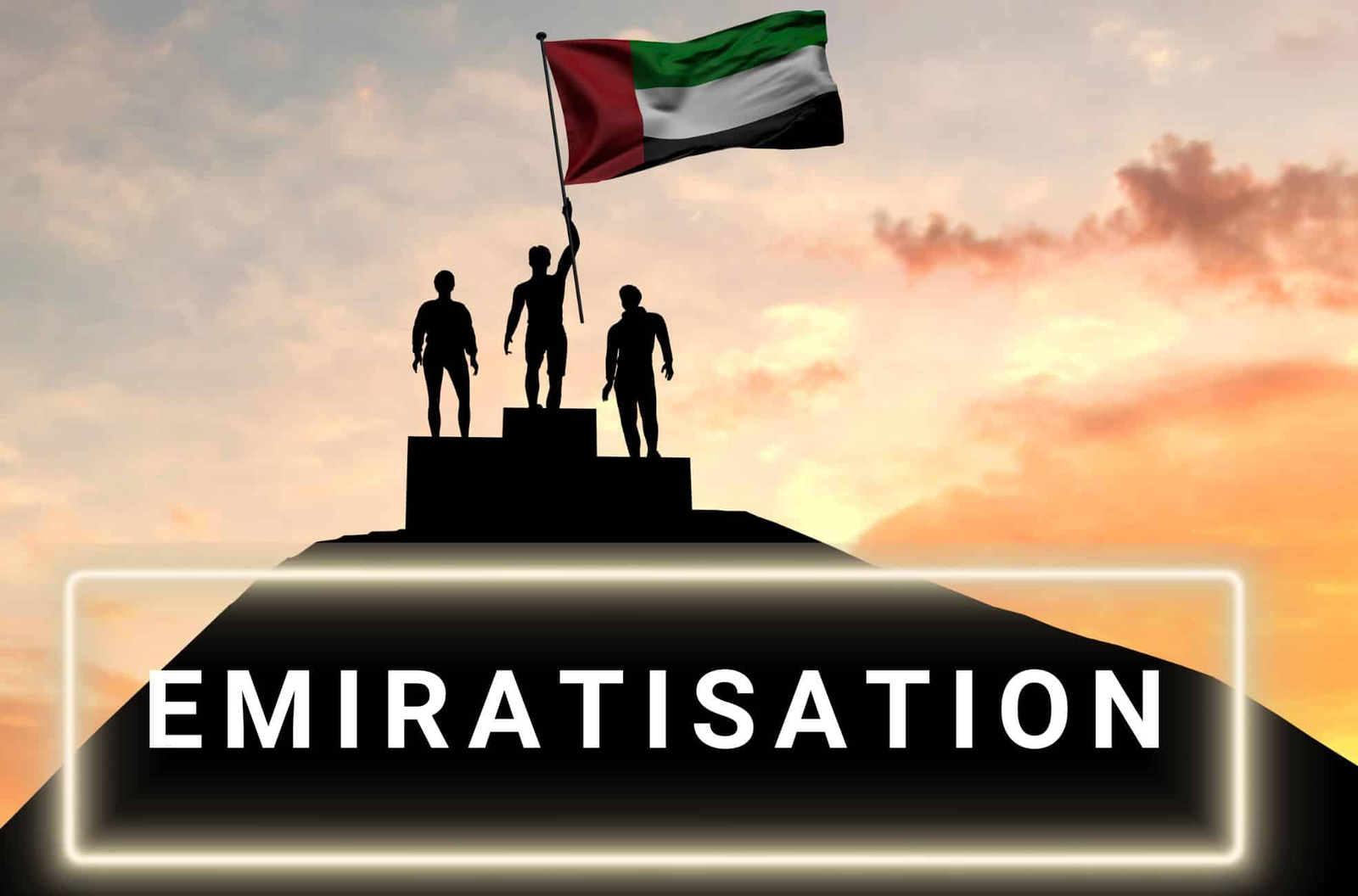Now Reading: 9 Enlightening Effects of 2025 Emiratisation Goals
-
01
9 Enlightening Effects of 2025 Emiratisation Goals
9 Enlightening Effects of 2025 Emiratisation Goals

Table of Contents
Emiratisation : Dubai’s real estate market, a global hub delivering 6-8% rental yields and tax-free capital gains, is navigating a transformative phase in 2025, with a projected 15% price decline per Fitch Ratings. The UAE’s 2025 Emiratisation goals, a cornerstone of Vision 2030, mandate a 2% annual increase in Emirati employment in skilled private sector roles, aiming for 10% by 2026, with a key deadline of June 30, 2025, for a 1% semi-annual increase.
Supported by the NAFIS program and initiatives like the Dubai Real Estate Brokers Programme, these goals significantly impact the real estate sector, which recorded AED 761 billion in transactions in 2024. This guide, written in clear, SEO-friendly language with an engaging tone, outlines nine enlightening effects of the 2025 Emiratisation goals on Dubai’s real estate market, tailored for U.S. investors, with data-driven insights, legal considerations, and risk analysis.
9 Enlightening Effects of 2025 Emiratisation Goals

1. Boosted Local Talent in Real Estate Brokerage
The Dubai Real Estate Brokers Programme, a flagship initiative, trains Emiratis in brokerage, valuation, and sales, increasing their presence in firms like Emaar and DAMAC. Over 500 Emiratis enrolled in 2024, per DLD.
- Effect: Emirati brokers enhance market trust, driving 10% more transactions in JVC and Dubai Marina, as locals prefer culturally aligned agents.
- Investor Benefit: U.S. investors gain access to skilled Emirati brokers, securing 6-8% yields with fewer disputes.
- Example: A U.S. expat hires an Emirati broker for a AED 1.2 million Dubai Hills deal, saving AED 12,000 in fees due to local expertise.
- Source: Dubai Land Department
2. Increased Operational Efficiency Through NAFIS
The NAFIS platform connects real estate firms with Emirati talent, offering wage subsidies (up to 50% of salaries) and training, reducing recruitment costs by 20%, per DAMAC Properties.
- Effect: Firms like Nakheel hire Emiratis for property management, cutting overheads by 15% and improving service delivery for 900,000 rental contracts in 2024.
- Investor Benefit: Lower management fees (5-7% of rent) for U.S.-owned properties in JVC, boosting net yields to 7-8%.
- Example: A AED 600,000 JVC unit’s management costs drop from AED 4,800 to AED 4,200 annually, saving USD 163.
- Source: DAMAC Properties
3. Enhanced Market Competitiveness
Emiratisation positions Emirati-led firms as regional leaders, with 25% of 2024 brokerage deals involving Emirati agents, per Economy Middle East, strengthening Dubai’s global appeal.
- Effect: Increased foreign investment (AED 376 billion in 2024) as Emirati talent enhances Dubai’s reputation, offsetting the 15% price decline.
- Investor Benefit: U.S. investors benefit from 10-15% appreciation in prime areas like Palm Jumeirah by 2028, driven by market stability.
- Example: A AED 2 million Palm Jumeirah unit gains AED 300,000 in value by 2027, with Emirati-led firms attracting global buyers.
- Source: Economy Middle East
4. Government Incentives for Compliant Firms

Companies meeting Emiratisation targets (e.g., 2% annual increase for 50+ employees) receive subsidies, reduced fees, and priority in government contracts, per MoHRE.
- Effect: Real estate developers like Emaar secure 20% more DLD contracts, reducing project costs by 5-10% and stabilizing off-plan prices.
- Investor Benefit: U.S. investors access off-plan units in Dubai South (from AED 800,000) at 5% lower prices, yielding 6-7%.
- Example: A AED 1 million Dubai South unit costs AED 950,000 due to developer subsidies, saving USD 13,613.
- Source: DAMAC Properties
5. Strengthened Local Market Dynamics
Emiratisation fosters local demand, with Emirati professionals (earning AED 10,000-20,000 monthly) driving 12% of 2024 residential purchases, per CBRE.
- Effect: Increased demand in mid-range areas like JVC supports 6-8% yields, cushioning the projected price decline.
- Investor Benefit: U.S. investors in JVC properties (from AED 600,000) see stable rents, with 80% occupancy rates.
- Example: A AED 68,000 annual rental income from a JVC unit remains steady, yielding USD 18,512 after U.S. taxes (24%).
- Source: DAMAC Properties
6. Innovation Through Emirati Training
The Dubai Real Estate Brokers Programme emphasizes PropTech and AI, training Emiratis to use tools like the Smart Rental Index, improving transaction efficiency by 15%, per DLD.
- Effect: Faster deal closures (10 days vs. 15) and accurate valuations reduce disputes by 10%, per RERA.
- Investor Benefit: U.S. investors close deals on Dubai Marina units (from AED 1.2 million) faster, saving AED 5,000 in legal fees.
- Example: A AED 1.8 million Marina Shores purchase completes in 8 days, with Emirati agents using AI tools, saving USD 1,361.
- Source: Dubai Land Department
7. Penalties Drive Compliance and Stability
Non-compliance with Emiratisation (e.g., missing 1% growth by June 30, 2025) incurs fines of AED 108,000 per unfilled position, pushing firms to hire Emiratis, per MoHRE.
- Effect: Stable workforce in real estate firms ensures consistent project delivery, with 90,000 units completed in 2025, per Fitch.
- Investor Benefit: U.S. investors face fewer delays in off-plan projects, securing 6-7% yields in Dubai Hills.
- Example: A AED 1.5 million Dubai Hills unit is delivered on time, yielding AED 105,000 annually, avoiding AED 50,000 delay costs.
- Source: DAMAC Properties
8. Sustainable Workforce Development
NAFIS’s training programs upskill Emiratis for roles in sales, property management, and development, reducing reliance on expatriates by 10% in 2024, per ValuStrat.
- Effect: Long-term market stability as Emirati expertise supports 226,000 transactions in 2024, per Emaar Properties.
- Investor Benefit: U.S. investors benefit from reliable local teams, ensuring 8-10% Airbnb yields in prime areas.
- Example: A AED 1.8 million Dubai Marina unit earns AED 180,000 via Airbnb, managed by Emirati staff, saving AED 10,000 in fees.
- Source: Emaar Properties
9. Cultural Alignment Enhances Investor Trust
Emirati professionals, trained to understand local values, foster trust among investors, with 30% of U.S. buyers preferring Emirati agents in 2024, per Knight Frank.
- Effect: Increased U.S. investment (12% of AED 376 billion in 2024) as cultural alignment reduces perceived risks, per DLD.
- Investor Benefit: U.S. expats secure 10-15% gains in Dubai South by 2028, leveraging Emirati-led firms for seamless deals.
- Example: A AED 800,000 Dubai South unit appreciates to AED 920,000 by 2027, with an Emirati broker saving AED 8,000 in fees.
- Source: Dubai Land Department
Legal Considerations for U.S. Expats
- UAE Tax Framework:
- Corporate Tax: 9% on taxable income above AED 375,000, with 0% for QFZPs or Small Business Relief (revenue below AED 3 million). Residential rental income is exempt.
- VAT: 5% on commercial transactions, recoverable for businesses. Residential rentals are exempt.
- Compliance: Register for corporate tax by March 31, 2025, for natural persons with AED 1 million turnover. File returns by September 30, 2025, for 2024. Penalties: AED 10,000 for late registration, AED 500-1,000 monthly for late filings.
- U.S. Tax Framework:
- Reporting: Declare worldwide income under FATCA via Forms 8858, 1116, and Schedule E. Income taxed at 10-37%, capital gains at 0-20%.
- Foreign Tax Credit (FTC): Offset U.S. tax with UAE corporate tax paid.
- FEIE: Exclude USD 130,000 of earned income if resident in UAE for 330 days.
- Freehold Ownership: U.S. investors can own properties in freehold zones (e.g., Dubai Marina, JVC), registered with DLD.
- Golden Visa: Properties worth AED 2 million qualify for a 10-year visa.
- Transaction Fees: 4% DLD fee (split with seller), 2% agency fee, AED 540-4,200 registration fees.
Risks and Mitigation
- Oversupply: 210,000–250,000 units by 2026 may deepen price declines. Invest in prime areas like Dubai Marina for 8-10% yields.
- Compliance Costs: Emiratisation fines (AED 108,000 per position) increase expenses. Use NAFIS to hire Emiratis, saving 50% on salaries.
- U.S. Tax Burden: IRS reporting reduces net returns. Claim FTC and FEIE, consulting advisors.
- Skill Gaps: Emirati talent may lack experience. Leverage NAFIS training to ensure competence.
- Market Volatility: U.S. interest rates (6-7% in 2025) may curb demand. Dubai’s 18.7 million visitors in 2024 sustain rental income.
Step-by-Step Guide for U.S. Investors
- Research Emiratisation Benefits: Study NAFIS and the Dubai Real Estate Brokers Programme.
- Engage Emirati Talent: Hire Emirati brokers or managers via NAFIS for JVC or Dubai Marina properties, saving 20% on costs.
- Select Properties: Target off-plan units in Dubai South (from AED 800,000) or ready properties in Dubai Marina (from AED 1.2 million).
- Structure Business: Set up a QFZP in DMCC for 0% tax, registering by March 31, 2025.
- Meet Compliance: Ensure firms meet 1% Emiratisation growth by June 30, 2025, avoiding AED 108,000 fines.
- File Taxes: Submit UAE returns by September 30, 2025, and U.S. returns with FTC or FEIE by April 15, 2025.
- Monitor Returns: Track 6-10% yields and 10-15% appreciation by 2028, reinvesting savings from Emirati efficiencies.
Conclusion
The 2025 Emiratisation goals, with a 1% semi-annual target by June 30, transform Dubai’s real estate market by integrating Emirati talent, boosting efficiency, and fostering trust. U.S. investors benefit from 6-10% yields, 10-15% appreciation by 2028, and cost savings via NAFIS, despite a 15% price decline forecast. By leveraging Emirati brokers, compliant firms, and prime investments in JVC or Dubai Marina, investors can navigate risks like oversupply and compliance costs. watch more
read more: 7 Significant Free Zone Business Licensing Reforms for 2025





















